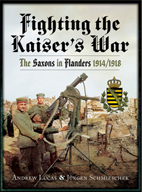CHAPTER 11 describes the experiences of 58. Infanterie-Division at Houthulst Forest, Poelkapelle and Langemarck in the awful final phase of the Third Battle of Ypres, over the following winter and in the spring advance in 1918.
It includes the vivid eyewitness account (taken from his autobiography) of HRH Prince Ernst Heinrich of Saxony, who served in the division with Feldartillerie-Regiment Nr. 115 from October 1917. At his own insistent request, the King of Saxony's youngest son was the only member of the Saxon royal family to serve in a combat role on an active sector of the Western Front. His description of what he saw and experienced as a battery commander in the poisoned remains of Houthulst Forest is by turns moving and horrific.
Please note that the chapter ends at the point when the 58. Infanterie-Division was relieved from its sector near Langemarck on 12th May 1918. We decided that we did not have enough fresh material for it to be worth covering their subsequent tour in the Kemmelberg (Mont Kemmel) sector, which we originally summarised in Fighting the Kaiser's War (that volume also contains the personal story of one of the many who died there).
Above: This photo is taken from the album of a member of Divisions-Funker-Abteilung 14, depicting an infantry immediate reserve (Bereitschaft) position near their radio station in Houthulst Forest. This specialist unit was the only Saxon formation remaining here after the relief of 58. Infanterie-Division at the end of November 1917. The ghastly dead foliage appears spectrally beautiful with its covering of snow. On the western side of the forest, the trees had long been obliterated by the British and French artillery.
Above: This photo is from a group belonging to Leutnant der Reserve Hugo Eberwein of IR 106; another picture from the same group (taken at Houthulst Forest) is featured on p.181 of Fighting the Kaiser's War. Depicted here are old dugouts near the long-destroyed La Truie Farm west of La Basse Ville, which lay in the rear area of 58. Infanterie-Division while it was holding the Kemmelberg in May 1918. La Truie Farm would have been familiar to the surviving veterans of IR 106 from the regiment's time at Ploegsteert Wood (November 1914 to March 1915). Thus after a little over three years, they had come full circle.
Above: The site of La Truie Farm, one of a number of locations misspelled on this 1915-1916 map taken from the regimental history of IR 104.

Above: Sample pages from For King and Kaiser (chapter 11).








